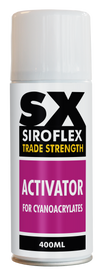ADHESIVES
For adhering materials in general two methods can be used. On one hand we have the mechanical fixings like screws and pop-nails. The second method is...
Read moreSegments
Technologies
Filter
3 products found
Superglue Activator
Activator for cyanoacrylates

Mitre Bonding System
High strength bonding system kit for use in the trade

ADHESIVES
For adhering materials in general two methods can be used. On one hand we have the mechanical fixings like screws and pop-nails. The second method is using an adhesives.
For an adhesive application, again two different types of bonding technology can be made. The craftsman and industry can choose between a hard and non-flexible adhesive and a softer more flexible type of adhesive. The world of softer more flexible adhesives has experienced a huge development in recent years. Not only growing number of volumes but also a growing variety of bonding possibilities.
Flexible bonding vs. a mechanical fixing
The first question we can ask ourselves is why we should we choose a flexible adhesivebonding instead of a mechanical fixing? There are numerous reasons answers are numerous:
• Prevents corrosion
• Prevents dust
• Prevents damages
• Prevents sound transmission
• Prevents sound vibrations
• Absorbsing expansion differences
• Spread of power Even spread of load
• Ability tofor repairing
• Labour costs reductionReduction in labour costs
In the above mentioned list Den Braven provides evident evidence that in many “fixing” applications flexible adhesives are preferable and outperform mechanical fixings. Of course adhesives can have some disadvantages compared to mechanical fixings. Den Braven will not recommend an adhesive if the surfaces are not sufficiently cleaned and/ or dry. The decisionchoice to use a flexible adhesive is alwaysmeans weighing up the pros and cons.
Characteristics of flexible adhesives
Den Braven will prescribe advise the most common characteristic features of flexible adhesives to support you in your product and application choice. Den Braven also does also have has a unique tool on the website to find the most suitable product for your application. Please follow the hyperlink Product Recommendation Tool.
• 1 component
• Moisture curing
• Skin formation between 5 and 15 minutes
• Curing speed variesying from 1 till to 5 mm per 24 hours
• Flexible
• Wide adhesion spectrum
Basic technologies
For a long time flexible adhesives were made out of Polyurethanes. However, in recent years the hybrid based adhesives are gaining more and more field.popularity. Hybrids roughly come in two different technologytechnologies, Silylated Urethane based Hybrids and Silylated Polyether based Hybrids. However, these two technologies show tiny differences,differences; in general these products are recogniszable because they are filled in the standard conventional cartridges instead of the aluminium cartridges for the Polyurethane adhesives. Furthermore, hybrids in comparison to Polyurethanes are:
• More environmentally friendlier
• Outperform in elasticity and durability
• Better resistance to UV
• Don’t have the bubble effect due to isocyanates
• Free of dangerous onerous labelling
How to apply adhesives
Den Braven always recommends to make carry out a test prior to the real application. Always clean the surfaces to be bonded carefully and ensureassure that the surface is dry. If necessary, degrease the surface thoroughly. Sanding of the surface is generally not recommended by Den Braven as the adhesive is in many cases too thick (thixotropic) to fill possible grooves in the surface.
The adhesive is should be applied in strips with a diameter of 8 mm. If the bonded area is larger, you will need more adhesive strips with a mutual distance in between of 10cm up to 40 cm. Especially where a difference in deformation is expected due to linear movement in the adjacent surfaces, the recommendation in order to maintain the final adhesive thickness of about 3 mm is by using an 2-sided adhesive foam tape of 3 mm in height.
Once the adhesive has been applied the second material/surface can be placed into position. There is no necessity to wait as is the case with some other adhesives may need. It is even necessary to place the second material directly to avoid skin formation due to “drying” of the flexible adhesive. Once If the second surface is placed do not press firmly. The materials can still be moved and be brought into the correct position. Once properly aligned press firmly to ensure a full adhesion connection to both surfaces.
Due to the chemical process of moisture curing the total curing time may take a longer. Water vapour from in the air will start the curing reaction. This process is relatively slow. The flexible adhesive will cure with a few millimetres per 24 hours. If the adhesive is even more closed off from the water vapour out of the air, the curing time will slow down. For this reason it is very important to apply your the adhesive in strips for ventilation and not providing the apply the adhesive to the whole surface.